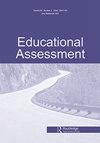测量项目对诊断分类模型的影响
IF 2.3
Q1 EDUCATION & EDUCATIONAL RESEARCH
引用次数: 0
摘要
本文章由计算机程序翻译,如有差异,请以英文原文为准。
Measuring Item Influence for Diagnostic Classification Models
ABSTRACT Diagnostic classification models (DCMs) are psychometric models that provide probabilistic classifications of examinees on a set of discrete latent attributes. When analyzing or constructing assessments scored by DCMs, understanding how each item influences attribute classifications can clarify the meaning of the measured constructs, facilitate appropriate construct representation, and identify items contributing minimal utility. In cases of short assessments, common in the DCM literature, item influence becomes paramount as individual items can have a disproportionate impact on, or entirely determine, classification. This study proposes four indices to quantify item influence and distinguishes them from other available item and test measures. We use simulation methods to evaluate and provide guidelines for interpreting each index, followed by a real data application to illustrate their use in practice. We discuss theoretical considerations regarding when influence presents a psychometric concern and other practical concerns such as how the indices function when reducing influence imbalance.
求助全文
通过发布文献求助,成功后即可免费获取论文全文。
去求助
来源期刊

Educational Assessment
EDUCATION & EDUCATIONAL RESEARCH-
CiteScore
3.20
自引率
6.70%
发文量
24
期刊介绍:
Educational Assessment publishes original research and scholarship on the assessment of individuals, groups, and programs in educational settings. It includes theory, methodological approaches and empirical research in the appraisal of the learning and achievement of students and teachers, young children and adults, and novices and experts. The journal reports on current large-scale testing practices, discusses alternative approaches, presents scholarship on classroom assessment practices and includes assessment topics debated at the national level. It welcomes both conceptual and empirical pieces and encourages articles that provide a strong bridge between theory and/or empirical research and the implications for educational policy and/or practice.
 求助内容:
求助内容: 应助结果提醒方式:
应助结果提醒方式:


